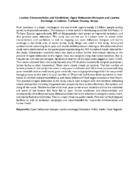| dc.description.abstract | Poor sanitation is a major challenge in the world with approximately 2.5 billion people lacking access to improved sanitation. The situation is even worse in developing countries like Kenya. In Turkana County, approximately 80% of the population lack access to improved sanitation, and thus practice open defecation. This study was carried out in Lodwar town to assess toilet characteristics and conditions as well as mapping out open defecation hotspots and latrine coverage in the study area. A social survey study design was used in this study. Structured questionnaires containing both open and closed ended questions relating to the objectives of the study were administered to the participants representing the 403 household heads selected for this study. Observation checklists were also used to obtain further information relating to the practice of open defecation in the region. Data was analyzed using descriptive statistics, that is, frequencies and valid percentages. Significance level for all the tests were pegged at alpha ≤ 0.05. The results obtained from this study showed only 19.1% of the households sampled possessed a latrine facility at their homestead. These were mainly simple pit latrines. The few number of latrines present in the study area were in very poor conditions with 46 latrines constructed using poor materials such as mud, wood, grass materials, mats and polythene bags which do not provide enough privacy to the users. A total number of 39 latrines had human feces scattered on their floors, 21 of them were/almost filled up with feces visible and 9 had stagnant water on their floors. The practice of open defecation in the study area is very rampant with the residents defecating almost everywhere including the government properties such as the arboretum, the stadium and along all the roads. The few number of latrines, poor construction materials and latrine untidiness are some of the factors that have led to poor latrine conditions and characteristics and consequently the widespread open defecation observed in the arboretum, along the roads, rivers, and nearby bushes and thickets. This is a major threat to public health. Provision of fecal disposal facilities as well as sanitation campaigns are recommended for improved environmental and human health. | en_US |

